Process for Handling Customer Complaint in Building and Construction Industry
VerifiedAdded on 2023/06/03
|11
|2119
|407
AI Summary
The article discusses the importance of adhering to quality standards in the construction industry and catering to customer complaints. It provides a standard operating procedure for handling customer complaints, including listening to the complaint, recording details, collecting facts, discussing options for fixing the problem, acting on the problem, keeping up to the quality promise, and follow up. The article also includes a flowchart outlining the complaint handling procedure.
Contribute Materials
Your contribution can guide someone’s learning journey. Share your
documents today.
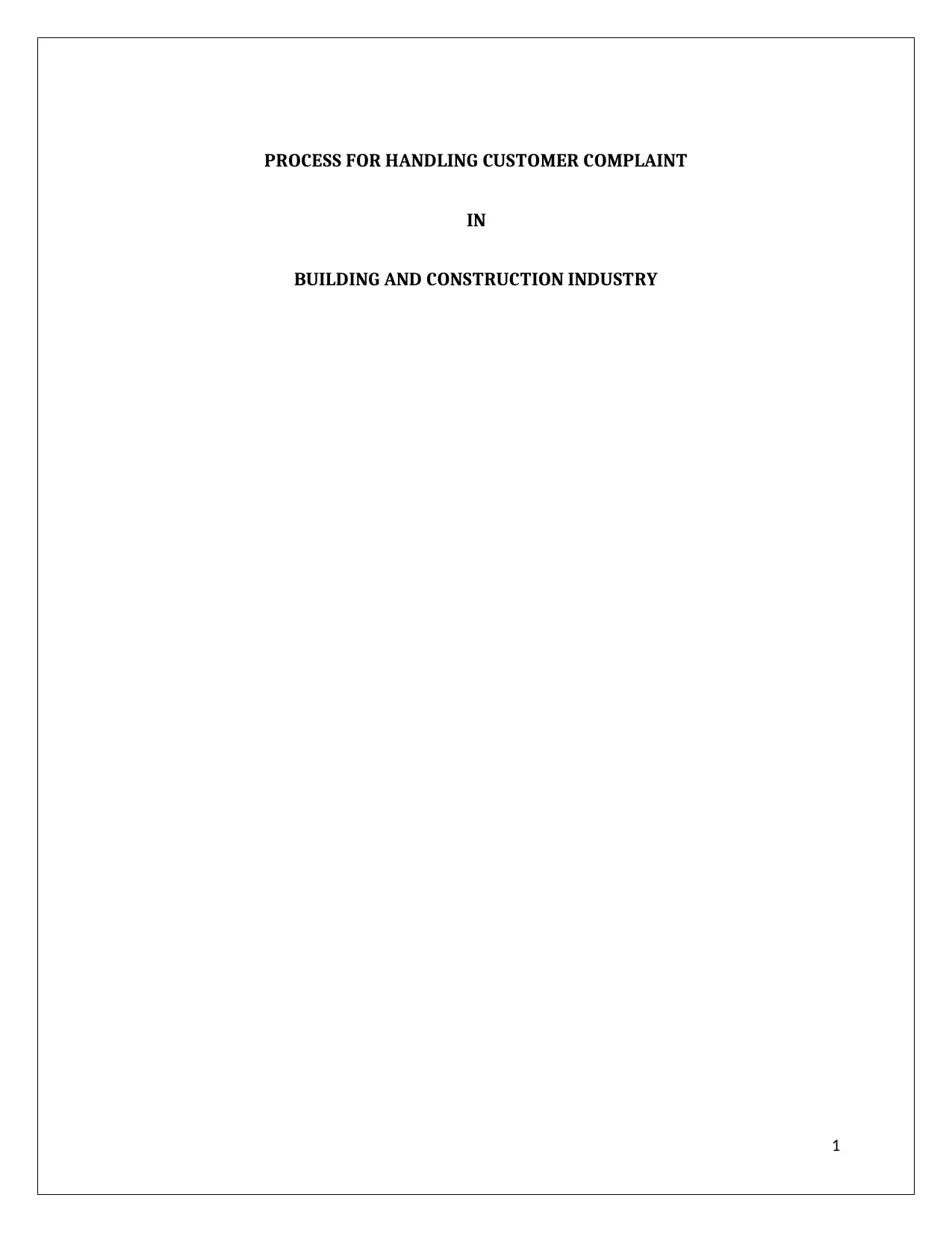
PROCESS FOR HANDLING CUSTOMER COMPLAINT
IN
BUILDING AND CONSTRUCTION INDUSTRY
1
IN
BUILDING AND CONSTRUCTION INDUSTRY
1
Secure Best Marks with AI Grader
Need help grading? Try our AI Grader for instant feedback on your assignments.
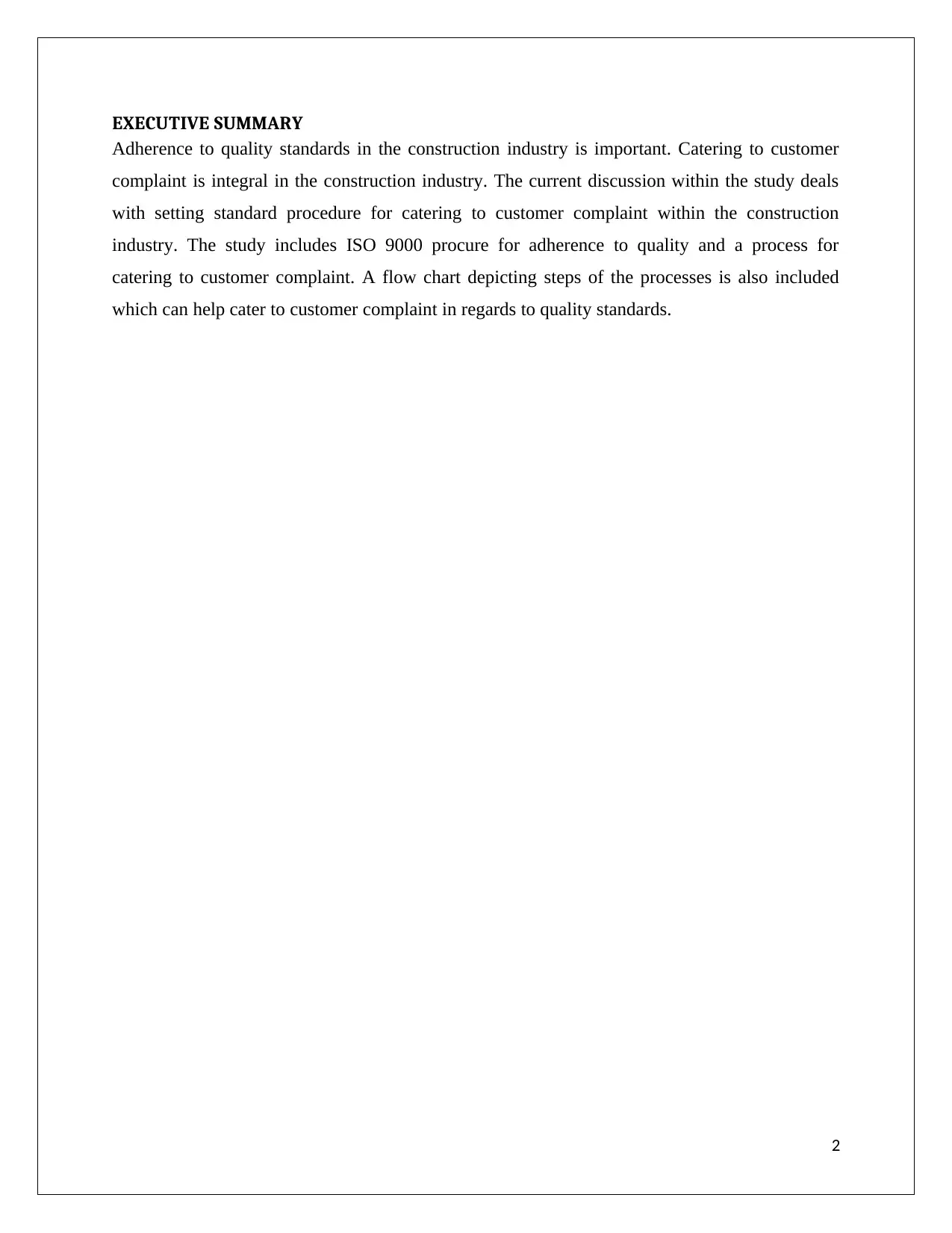
EXECUTIVE SUMMARY
Adherence to quality standards in the construction industry is important. Catering to customer
complaint is integral in the construction industry. The current discussion within the study deals
with setting standard procedure for catering to customer complaint within the construction
industry. The study includes ISO 9000 procure for adherence to quality and a process for
catering to customer complaint. A flow chart depicting steps of the processes is also included
which can help cater to customer complaint in regards to quality standards.
2
Adherence to quality standards in the construction industry is important. Catering to customer
complaint is integral in the construction industry. The current discussion within the study deals
with setting standard procedure for catering to customer complaint within the construction
industry. The study includes ISO 9000 procure for adherence to quality and a process for
catering to customer complaint. A flow chart depicting steps of the processes is also included
which can help cater to customer complaint in regards to quality standards.
2
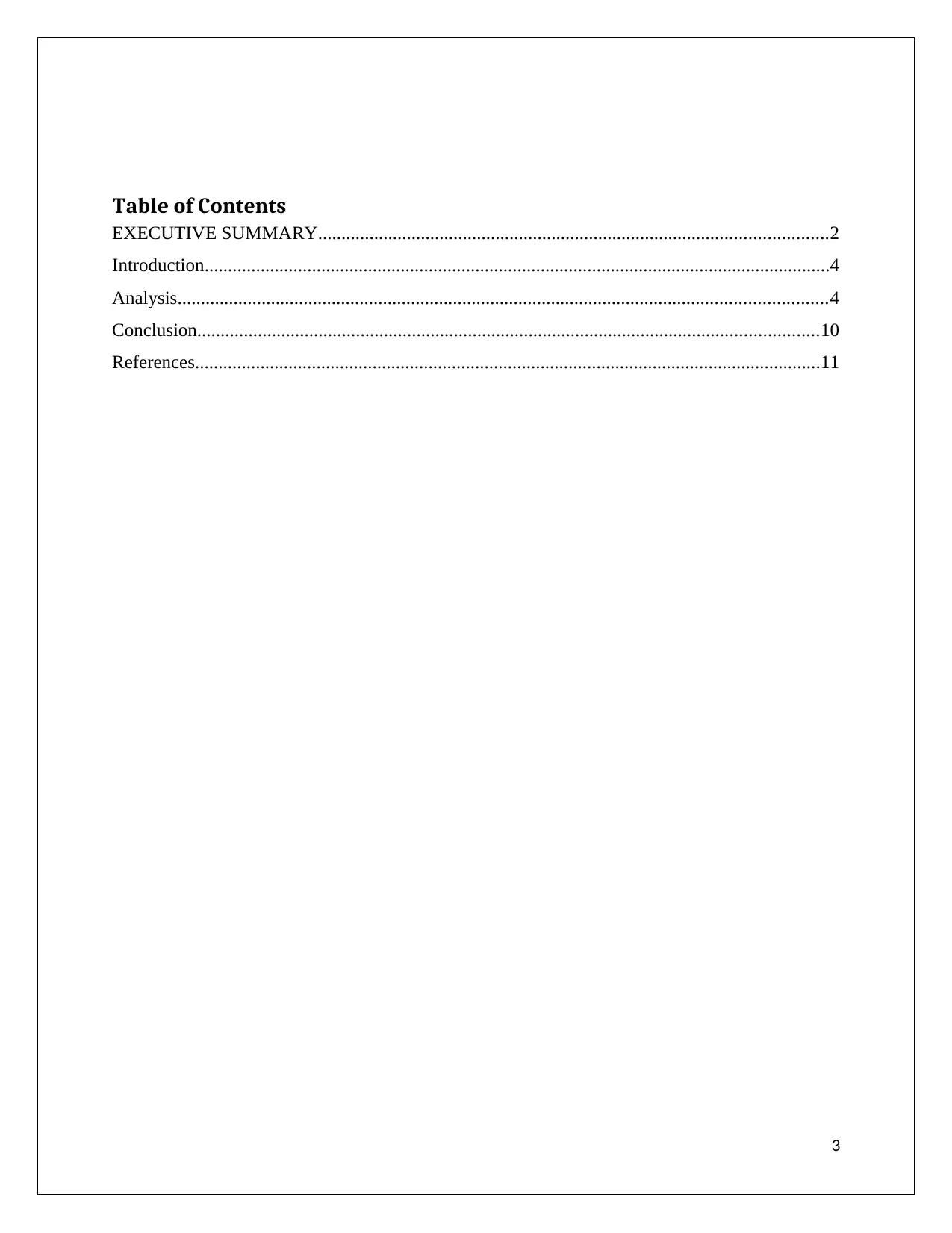
Table of Contents
EXECUTIVE SUMMARY.............................................................................................................2
Introduction......................................................................................................................................4
Analysis...........................................................................................................................................4
Conclusion.....................................................................................................................................10
References......................................................................................................................................11
3
EXECUTIVE SUMMARY.............................................................................................................2
Introduction......................................................................................................................................4
Analysis...........................................................................................................................................4
Conclusion.....................................................................................................................................10
References......................................................................................................................................11
3
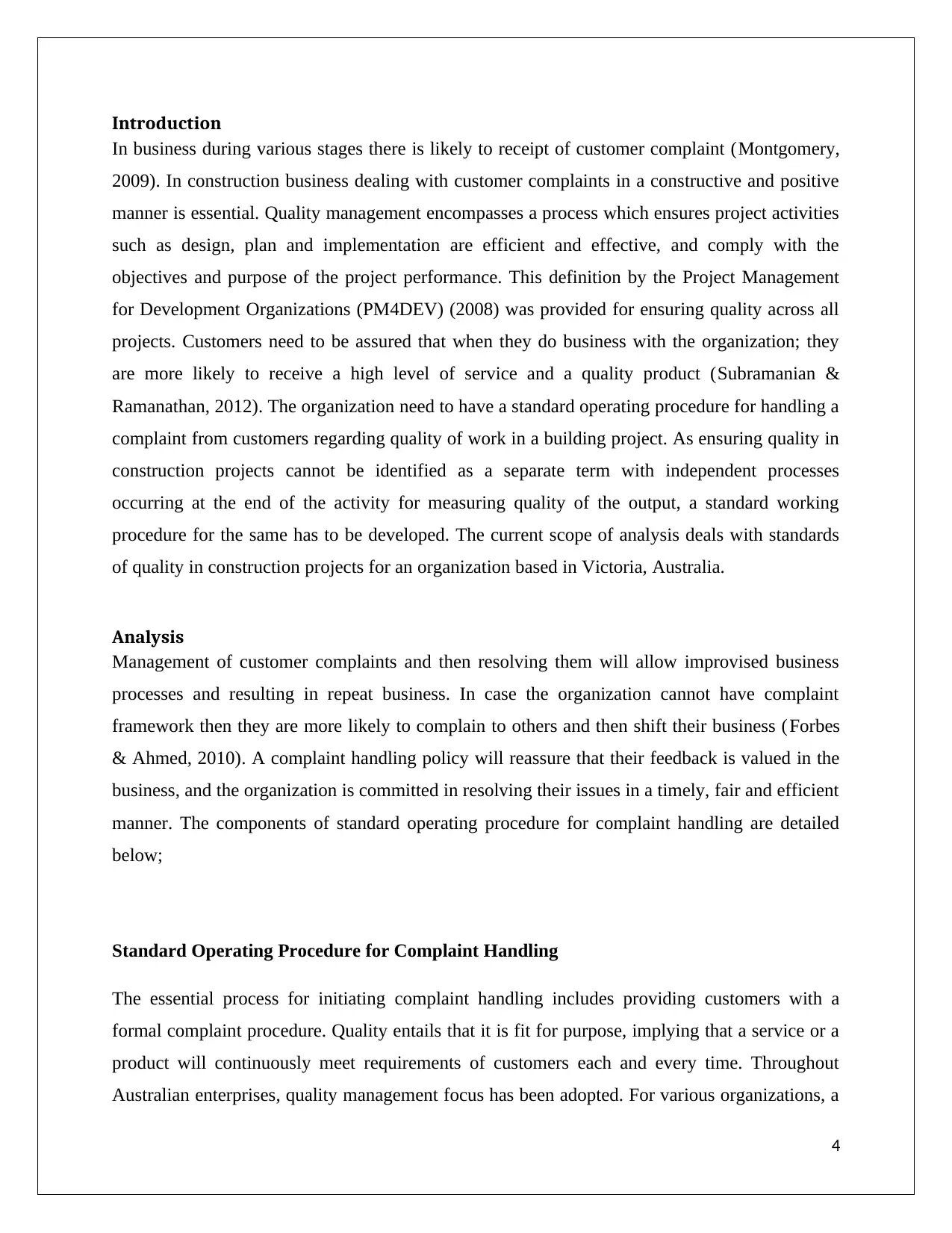
Introduction
In business during various stages there is likely to receipt of customer complaint (Montgomery,
2009). In construction business dealing with customer complaints in a constructive and positive
manner is essential. Quality management encompasses a process which ensures project activities
such as design, plan and implementation are efficient and effective, and comply with the
objectives and purpose of the project performance. This definition by the Project Management
for Development Organizations (PM4DEV) (2008) was provided for ensuring quality across all
projects. Customers need to be assured that when they do business with the organization; they
are more likely to receive a high level of service and a quality product (Subramanian &
Ramanathan, 2012). The organization need to have a standard operating procedure for handling a
complaint from customers regarding quality of work in a building project. As ensuring quality in
construction projects cannot be identified as a separate term with independent processes
occurring at the end of the activity for measuring quality of the output, a standard working
procedure for the same has to be developed. The current scope of analysis deals with standards
of quality in construction projects for an organization based in Victoria, Australia.
Analysis
Management of customer complaints and then resolving them will allow improvised business
processes and resulting in repeat business. In case the organization cannot have complaint
framework then they are more likely to complain to others and then shift their business (Forbes
& Ahmed, 2010). A complaint handling policy will reassure that their feedback is valued in the
business, and the organization is committed in resolving their issues in a timely, fair and efficient
manner. The components of standard operating procedure for complaint handling are detailed
below;
Standard Operating Procedure for Complaint Handling
The essential process for initiating complaint handling includes providing customers with a
formal complaint procedure. Quality entails that it is fit for purpose, implying that a service or a
product will continuously meet requirements of customers each and every time. Throughout
Australian enterprises, quality management focus has been adopted. For various organizations, a
4
In business during various stages there is likely to receipt of customer complaint (Montgomery,
2009). In construction business dealing with customer complaints in a constructive and positive
manner is essential. Quality management encompasses a process which ensures project activities
such as design, plan and implementation are efficient and effective, and comply with the
objectives and purpose of the project performance. This definition by the Project Management
for Development Organizations (PM4DEV) (2008) was provided for ensuring quality across all
projects. Customers need to be assured that when they do business with the organization; they
are more likely to receive a high level of service and a quality product (Subramanian &
Ramanathan, 2012). The organization need to have a standard operating procedure for handling a
complaint from customers regarding quality of work in a building project. As ensuring quality in
construction projects cannot be identified as a separate term with independent processes
occurring at the end of the activity for measuring quality of the output, a standard working
procedure for the same has to be developed. The current scope of analysis deals with standards
of quality in construction projects for an organization based in Victoria, Australia.
Analysis
Management of customer complaints and then resolving them will allow improvised business
processes and resulting in repeat business. In case the organization cannot have complaint
framework then they are more likely to complain to others and then shift their business (Forbes
& Ahmed, 2010). A complaint handling policy will reassure that their feedback is valued in the
business, and the organization is committed in resolving their issues in a timely, fair and efficient
manner. The components of standard operating procedure for complaint handling are detailed
below;
Standard Operating Procedure for Complaint Handling
The essential process for initiating complaint handling includes providing customers with a
formal complaint procedure. Quality entails that it is fit for purpose, implying that a service or a
product will continuously meet requirements of customers each and every time. Throughout
Australian enterprises, quality management focus has been adopted. For various organizations, a
4
Secure Best Marks with AI Grader
Need help grading? Try our AI Grader for instant feedback on your assignments.
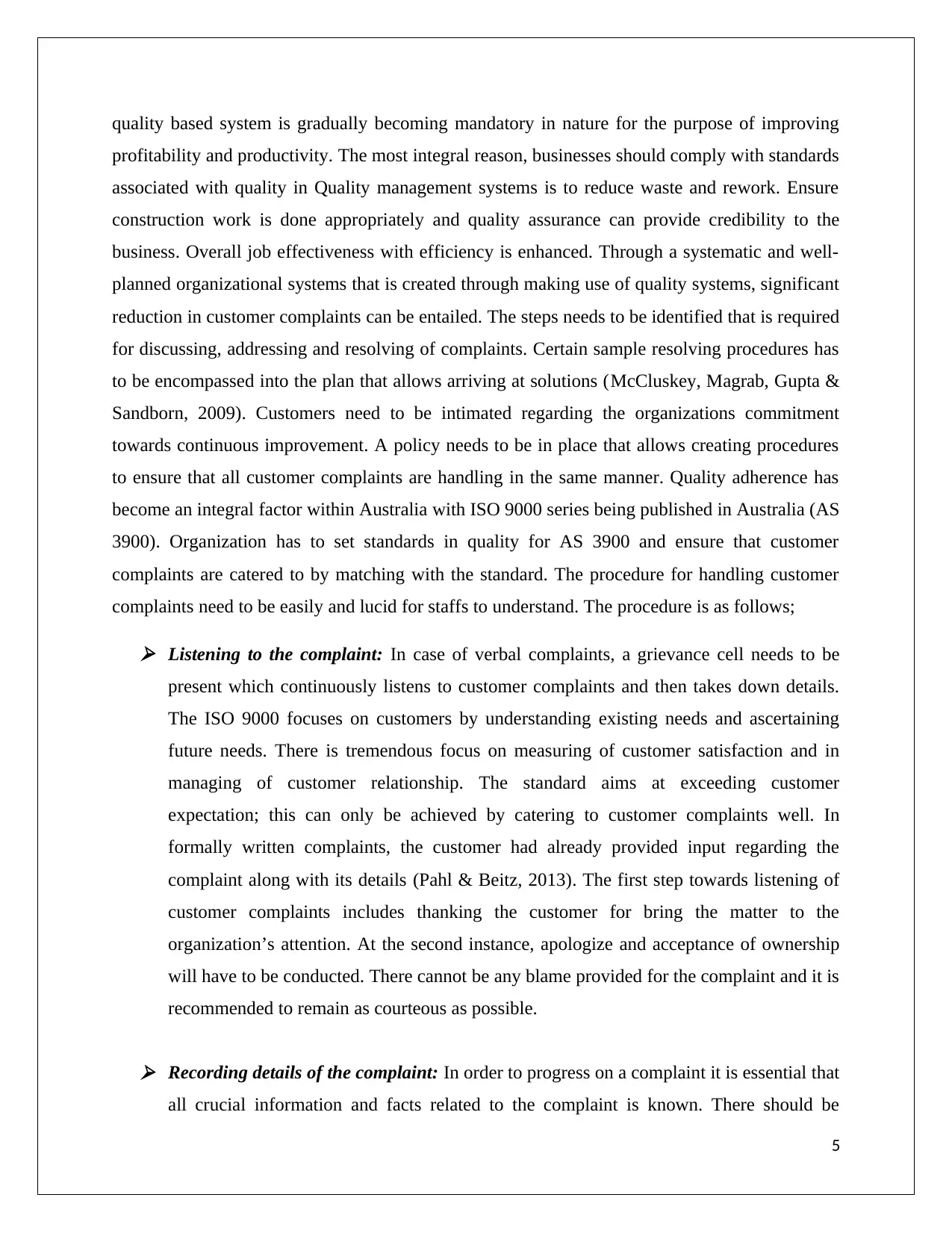
quality based system is gradually becoming mandatory in nature for the purpose of improving
profitability and productivity. The most integral reason, businesses should comply with standards
associated with quality in Quality management systems is to reduce waste and rework. Ensure
construction work is done appropriately and quality assurance can provide credibility to the
business. Overall job effectiveness with efficiency is enhanced. Through a systematic and well-
planned organizational systems that is created through making use of quality systems, significant
reduction in customer complaints can be entailed. The steps needs to be identified that is required
for discussing, addressing and resolving of complaints. Certain sample resolving procedures has
to be encompassed into the plan that allows arriving at solutions (McCluskey, Magrab, Gupta &
Sandborn, 2009). Customers need to be intimated regarding the organizations commitment
towards continuous improvement. A policy needs to be in place that allows creating procedures
to ensure that all customer complaints are handling in the same manner. Quality adherence has
become an integral factor within Australia with ISO 9000 series being published in Australia (AS
3900). Organization has to set standards in quality for AS 3900 and ensure that customer
complaints are catered to by matching with the standard. The procedure for handling customer
complaints need to be easily and lucid for staffs to understand. The procedure is as follows;
Listening to the complaint: In case of verbal complaints, a grievance cell needs to be
present which continuously listens to customer complaints and then takes down details.
The ISO 9000 focuses on customers by understanding existing needs and ascertaining
future needs. There is tremendous focus on measuring of customer satisfaction and in
managing of customer relationship. The standard aims at exceeding customer
expectation; this can only be achieved by catering to customer complaints well. In
formally written complaints, the customer had already provided input regarding the
complaint along with its details (Pahl & Beitz, 2013). The first step towards listening of
customer complaints includes thanking the customer for bring the matter to the
organization’s attention. At the second instance, apologize and acceptance of ownership
will have to be conducted. There cannot be any blame provided for the complaint and it is
recommended to remain as courteous as possible.
Recording details of the complaint: In order to progress on a complaint it is essential that
all crucial information and facts related to the complaint is known. There should be
5
profitability and productivity. The most integral reason, businesses should comply with standards
associated with quality in Quality management systems is to reduce waste and rework. Ensure
construction work is done appropriately and quality assurance can provide credibility to the
business. Overall job effectiveness with efficiency is enhanced. Through a systematic and well-
planned organizational systems that is created through making use of quality systems, significant
reduction in customer complaints can be entailed. The steps needs to be identified that is required
for discussing, addressing and resolving of complaints. Certain sample resolving procedures has
to be encompassed into the plan that allows arriving at solutions (McCluskey, Magrab, Gupta &
Sandborn, 2009). Customers need to be intimated regarding the organizations commitment
towards continuous improvement. A policy needs to be in place that allows creating procedures
to ensure that all customer complaints are handling in the same manner. Quality adherence has
become an integral factor within Australia with ISO 9000 series being published in Australia (AS
3900). Organization has to set standards in quality for AS 3900 and ensure that customer
complaints are catered to by matching with the standard. The procedure for handling customer
complaints need to be easily and lucid for staffs to understand. The procedure is as follows;
Listening to the complaint: In case of verbal complaints, a grievance cell needs to be
present which continuously listens to customer complaints and then takes down details.
The ISO 9000 focuses on customers by understanding existing needs and ascertaining
future needs. There is tremendous focus on measuring of customer satisfaction and in
managing of customer relationship. The standard aims at exceeding customer
expectation; this can only be achieved by catering to customer complaints well. In
formally written complaints, the customer had already provided input regarding the
complaint along with its details (Pahl & Beitz, 2013). The first step towards listening of
customer complaints includes thanking the customer for bring the matter to the
organization’s attention. At the second instance, apologize and acceptance of ownership
will have to be conducted. There cannot be any blame provided for the complaint and it is
recommended to remain as courteous as possible.
Recording details of the complaint: In order to progress on a complaint it is essential that
all crucial information and facts related to the complaint is known. There should be
5
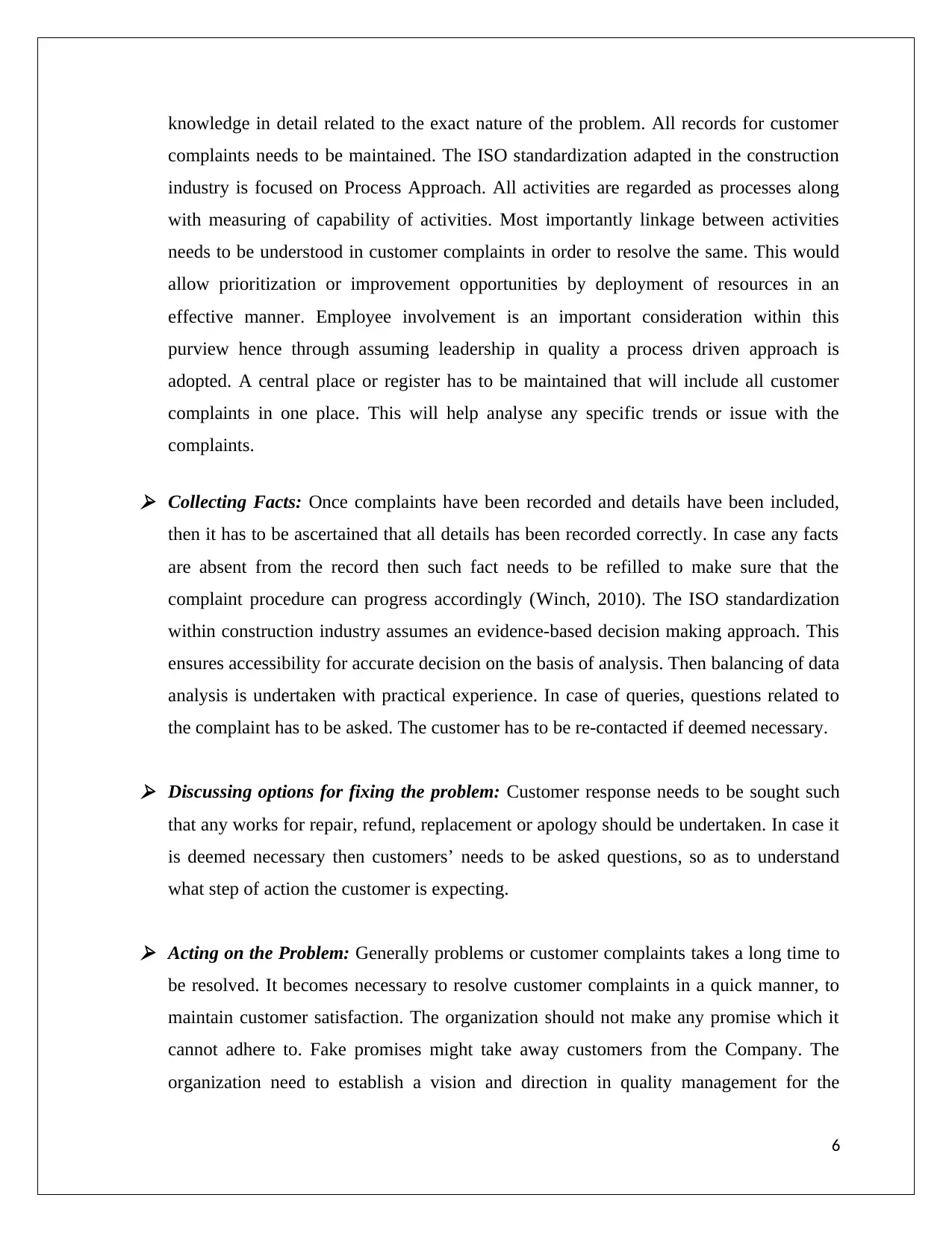
knowledge in detail related to the exact nature of the problem. All records for customer
complaints needs to be maintained. The ISO standardization adapted in the construction
industry is focused on Process Approach. All activities are regarded as processes along
with measuring of capability of activities. Most importantly linkage between activities
needs to be understood in customer complaints in order to resolve the same. This would
allow prioritization or improvement opportunities by deployment of resources in an
effective manner. Employee involvement is an important consideration within this
purview hence through assuming leadership in quality a process driven approach is
adopted. A central place or register has to be maintained that will include all customer
complaints in one place. This will help analyse any specific trends or issue with the
complaints.
Collecting Facts: Once complaints have been recorded and details have been included,
then it has to be ascertained that all details has been recorded correctly. In case any facts
are absent from the record then such fact needs to be refilled to make sure that the
complaint procedure can progress accordingly (Winch, 2010). The ISO standardization
within construction industry assumes an evidence-based decision making approach. This
ensures accessibility for accurate decision on the basis of analysis. Then balancing of data
analysis is undertaken with practical experience. In case of queries, questions related to
the complaint has to be asked. The customer has to be re-contacted if deemed necessary.
Discussing options for fixing the problem: Customer response needs to be sought such
that any works for repair, refund, replacement or apology should be undertaken. In case it
is deemed necessary then customers’ needs to be asked questions, so as to understand
what step of action the customer is expecting.
Acting on the Problem: Generally problems or customer complaints takes a long time to
be resolved. It becomes necessary to resolve customer complaints in a quick manner, to
maintain customer satisfaction. The organization should not make any promise which it
cannot adhere to. Fake promises might take away customers from the Company. The
organization need to establish a vision and direction in quality management for the
6
complaints needs to be maintained. The ISO standardization adapted in the construction
industry is focused on Process Approach. All activities are regarded as processes along
with measuring of capability of activities. Most importantly linkage between activities
needs to be understood in customer complaints in order to resolve the same. This would
allow prioritization or improvement opportunities by deployment of resources in an
effective manner. Employee involvement is an important consideration within this
purview hence through assuming leadership in quality a process driven approach is
adopted. A central place or register has to be maintained that will include all customer
complaints in one place. This will help analyse any specific trends or issue with the
complaints.
Collecting Facts: Once complaints have been recorded and details have been included,
then it has to be ascertained that all details has been recorded correctly. In case any facts
are absent from the record then such fact needs to be refilled to make sure that the
complaint procedure can progress accordingly (Winch, 2010). The ISO standardization
within construction industry assumes an evidence-based decision making approach. This
ensures accessibility for accurate decision on the basis of analysis. Then balancing of data
analysis is undertaken with practical experience. In case of queries, questions related to
the complaint has to be asked. The customer has to be re-contacted if deemed necessary.
Discussing options for fixing the problem: Customer response needs to be sought such
that any works for repair, refund, replacement or apology should be undertaken. In case it
is deemed necessary then customers’ needs to be asked questions, so as to understand
what step of action the customer is expecting.
Acting on the Problem: Generally problems or customer complaints takes a long time to
be resolved. It becomes necessary to resolve customer complaints in a quick manner, to
maintain customer satisfaction. The organization should not make any promise which it
cannot adhere to. Fake promises might take away customers from the Company. The
organization need to establish a vision and direction in quality management for the
6
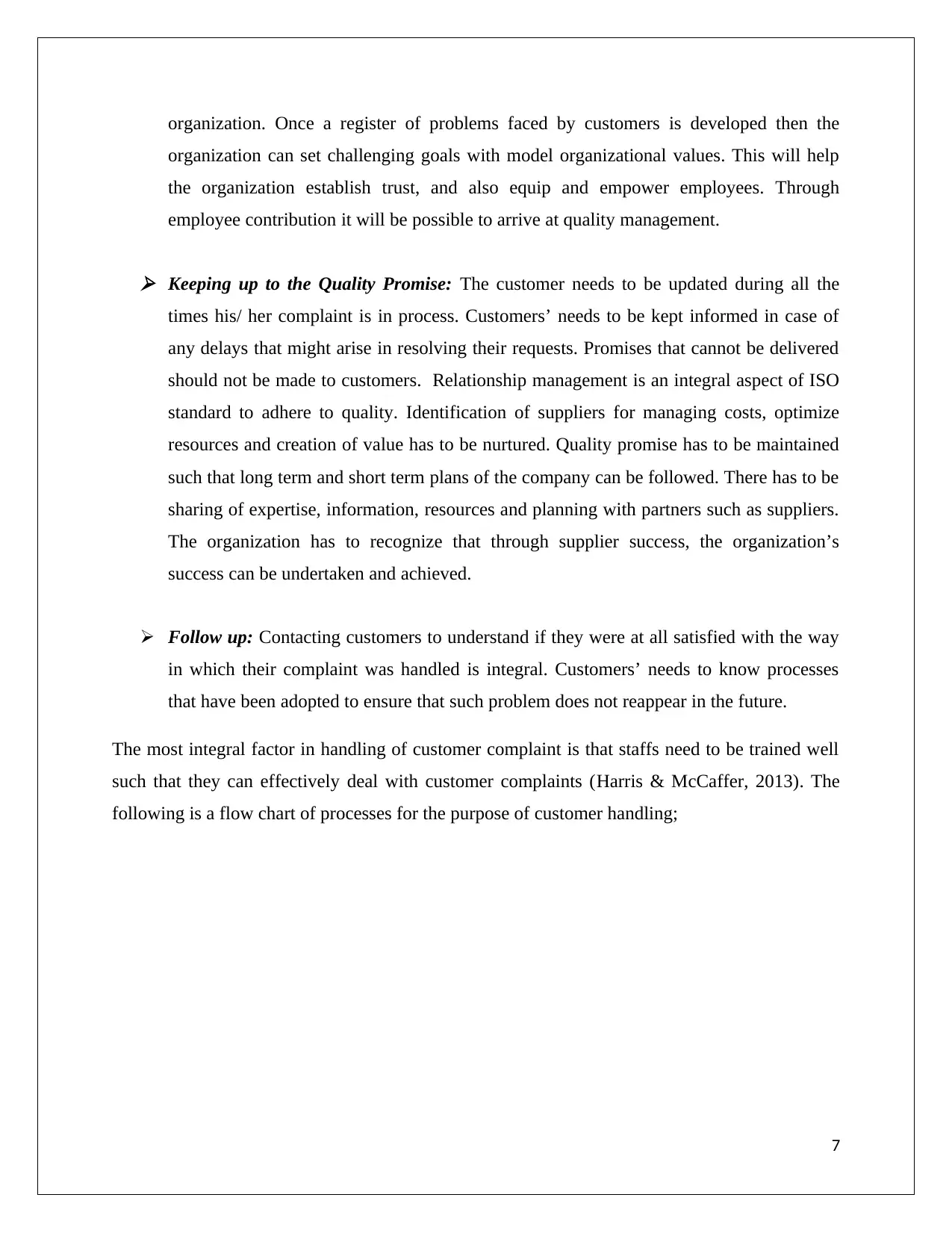
organization. Once a register of problems faced by customers is developed then the
organization can set challenging goals with model organizational values. This will help
the organization establish trust, and also equip and empower employees. Through
employee contribution it will be possible to arrive at quality management.
Keeping up to the Quality Promise: The customer needs to be updated during all the
times his/ her complaint is in process. Customers’ needs to be kept informed in case of
any delays that might arise in resolving their requests. Promises that cannot be delivered
should not be made to customers. Relationship management is an integral aspect of ISO
standard to adhere to quality. Identification of suppliers for managing costs, optimize
resources and creation of value has to be nurtured. Quality promise has to be maintained
such that long term and short term plans of the company can be followed. There has to be
sharing of expertise, information, resources and planning with partners such as suppliers.
The organization has to recognize that through supplier success, the organization’s
success can be undertaken and achieved.
Follow up: Contacting customers to understand if they were at all satisfied with the way
in which their complaint was handled is integral. Customers’ needs to know processes
that have been adopted to ensure that such problem does not reappear in the future.
The most integral factor in handling of customer complaint is that staffs need to be trained well
such that they can effectively deal with customer complaints (Harris & McCaffer, 2013). The
following is a flow chart of processes for the purpose of customer handling;
7
organization can set challenging goals with model organizational values. This will help
the organization establish trust, and also equip and empower employees. Through
employee contribution it will be possible to arrive at quality management.
Keeping up to the Quality Promise: The customer needs to be updated during all the
times his/ her complaint is in process. Customers’ needs to be kept informed in case of
any delays that might arise in resolving their requests. Promises that cannot be delivered
should not be made to customers. Relationship management is an integral aspect of ISO
standard to adhere to quality. Identification of suppliers for managing costs, optimize
resources and creation of value has to be nurtured. Quality promise has to be maintained
such that long term and short term plans of the company can be followed. There has to be
sharing of expertise, information, resources and planning with partners such as suppliers.
The organization has to recognize that through supplier success, the organization’s
success can be undertaken and achieved.
Follow up: Contacting customers to understand if they were at all satisfied with the way
in which their complaint was handled is integral. Customers’ needs to know processes
that have been adopted to ensure that such problem does not reappear in the future.
The most integral factor in handling of customer complaint is that staffs need to be trained well
such that they can effectively deal with customer complaints (Harris & McCaffer, 2013). The
following is a flow chart of processes for the purpose of customer handling;
7
Paraphrase This Document
Need a fresh take? Get an instant paraphrase of this document with our AI Paraphraser
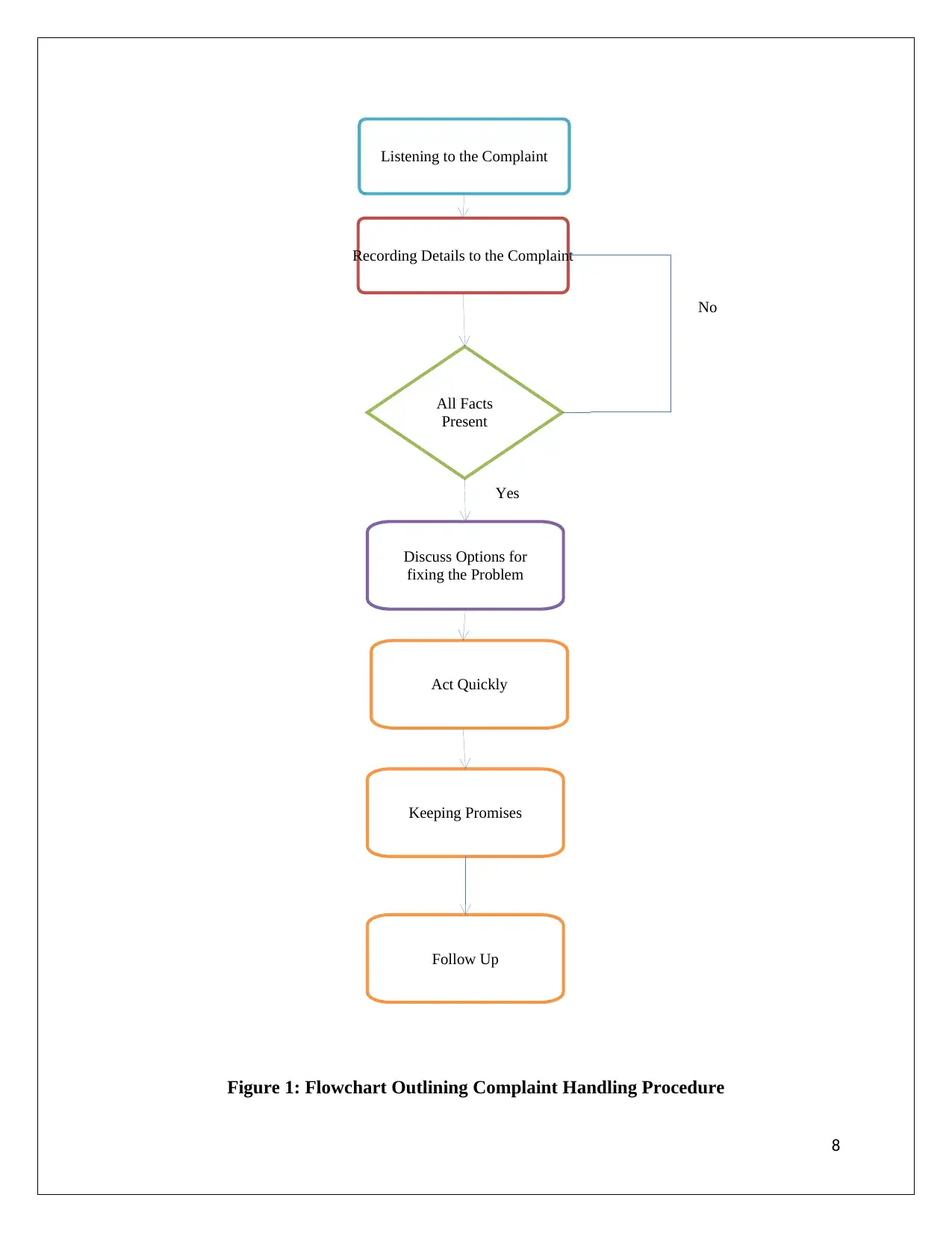
Listening to the Complaint
All Facts
Present
Recording Details to the Complaint
No
Discuss Options for
fixing the Problem
Act Quickly
Keeping Promises
Follow Up
Yes
Figure 1: Flowchart Outlining Complaint Handling Procedure
8
All Facts
Present
Recording Details to the Complaint
No
Discuss Options for
fixing the Problem
Act Quickly
Keeping Promises
Follow Up
Yes
Figure 1: Flowchart Outlining Complaint Handling Procedure
8
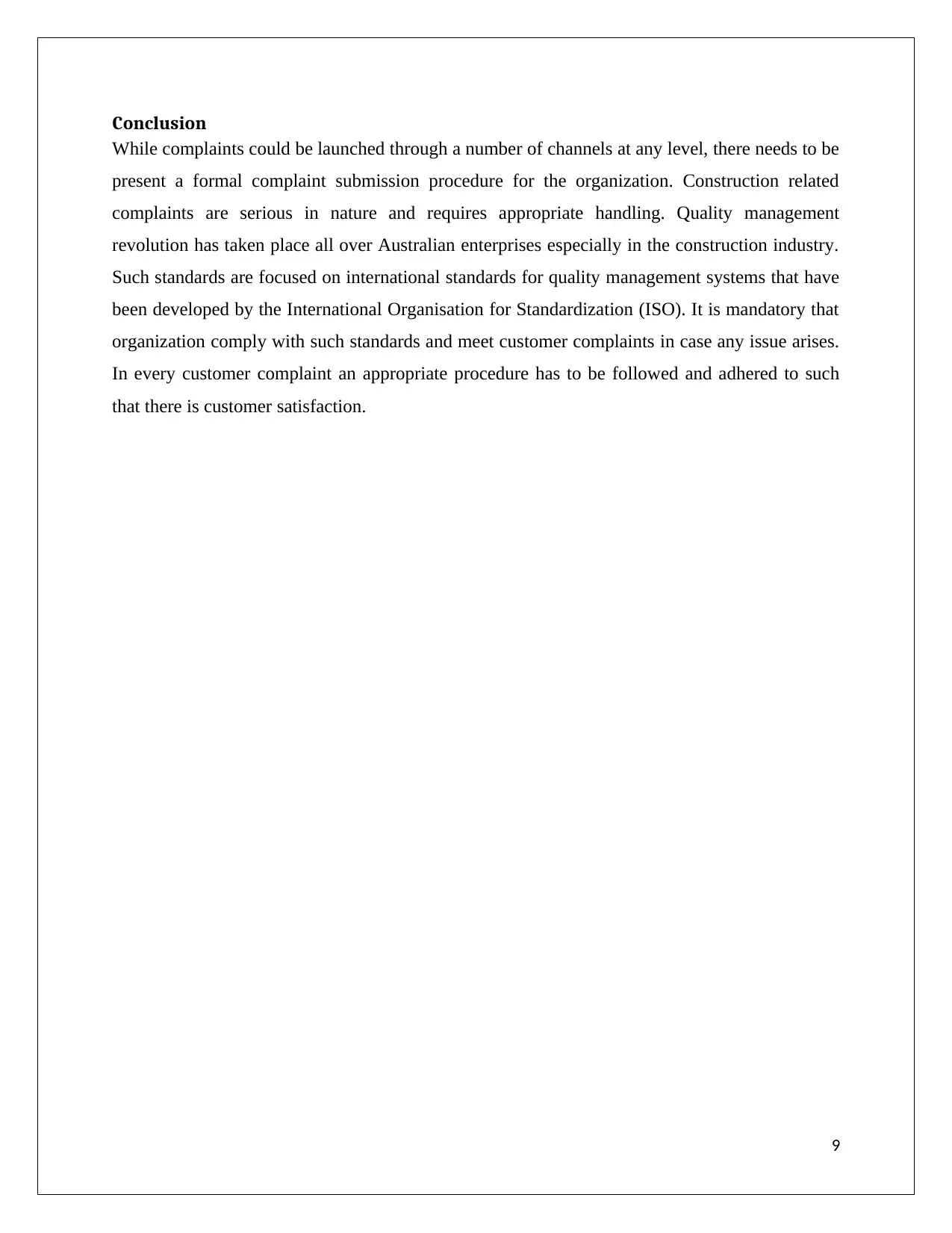
Conclusion
While complaints could be launched through a number of channels at any level, there needs to be
present a formal complaint submission procedure for the organization. Construction related
complaints are serious in nature and requires appropriate handling. Quality management
revolution has taken place all over Australian enterprises especially in the construction industry.
Such standards are focused on international standards for quality management systems that have
been developed by the International Organisation for Standardization (ISO). It is mandatory that
organization comply with such standards and meet customer complaints in case any issue arises.
In every customer complaint an appropriate procedure has to be followed and adhered to such
that there is customer satisfaction.
9
While complaints could be launched through a number of channels at any level, there needs to be
present a formal complaint submission procedure for the organization. Construction related
complaints are serious in nature and requires appropriate handling. Quality management
revolution has taken place all over Australian enterprises especially in the construction industry.
Such standards are focused on international standards for quality management systems that have
been developed by the International Organisation for Standardization (ISO). It is mandatory that
organization comply with such standards and meet customer complaints in case any issue arises.
In every customer complaint an appropriate procedure has to be followed and adhered to such
that there is customer satisfaction.
9
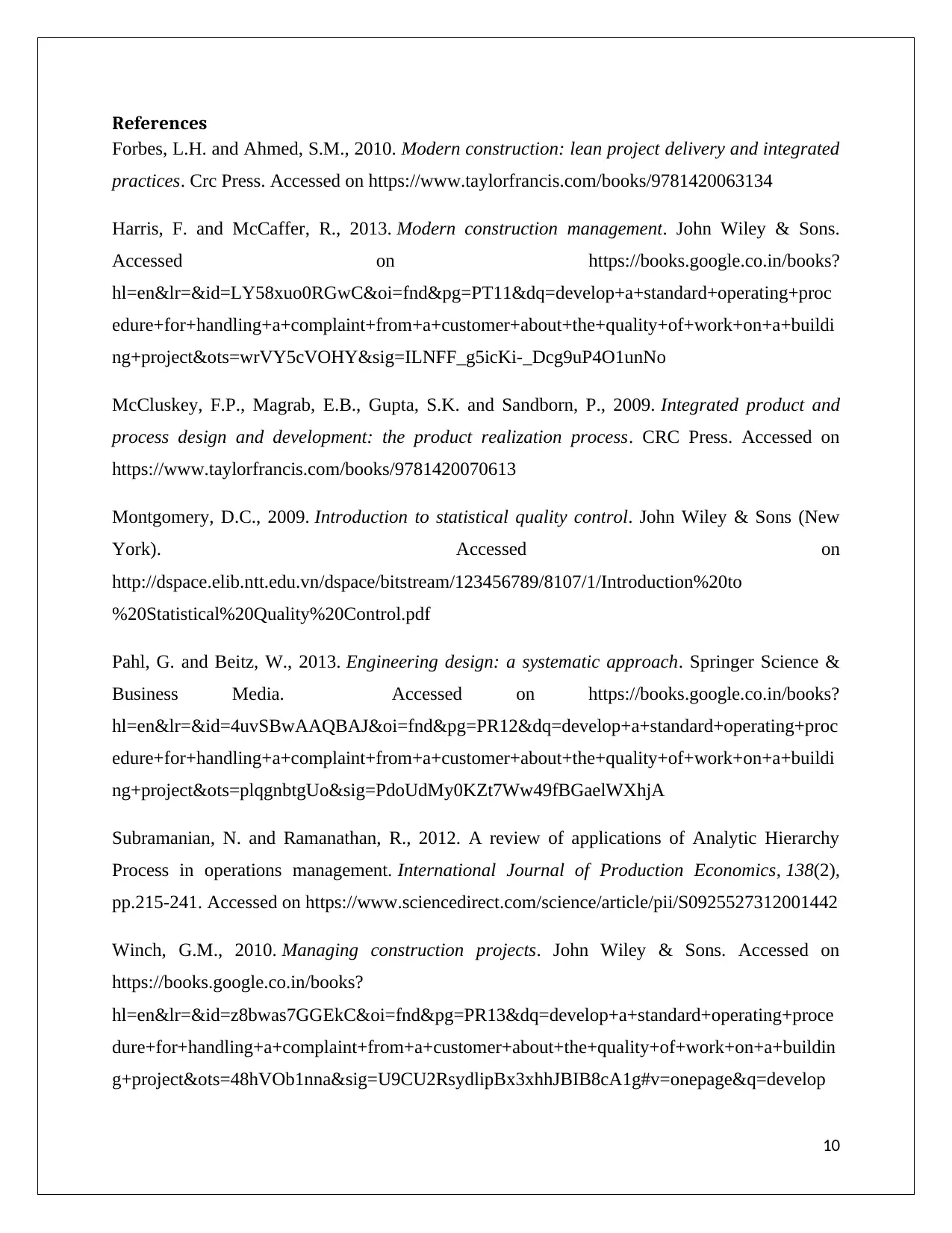
References
Forbes, L.H. and Ahmed, S.M., 2010. Modern construction: lean project delivery and integrated
practices. Crc Press. Accessed on https://www.taylorfrancis.com/books/9781420063134
Harris, F. and McCaffer, R., 2013. Modern construction management. John Wiley & Sons.
Accessed on https://books.google.co.in/books?
hl=en&lr=&id=LY58xuo0RGwC&oi=fnd&pg=PT11&dq=develop+a+standard+operating+proc
edure+for+handling+a+complaint+from+a+customer+about+the+quality+of+work+on+a+buildi
ng+project&ots=wrVY5cVOHY&sig=ILNFF_g5icKi-_Dcg9uP4O1unNo
McCluskey, F.P., Magrab, E.B., Gupta, S.K. and Sandborn, P., 2009. Integrated product and
process design and development: the product realization process. CRC Press. Accessed on
https://www.taylorfrancis.com/books/9781420070613
Montgomery, D.C., 2009. Introduction to statistical quality control. John Wiley & Sons (New
York). Accessed on
http://dspace.elib.ntt.edu.vn/dspace/bitstream/123456789/8107/1/Introduction%20to
%20Statistical%20Quality%20Control.pdf
Pahl, G. and Beitz, W., 2013. Engineering design: a systematic approach. Springer Science &
Business Media. Accessed on https://books.google.co.in/books?
hl=en&lr=&id=4uvSBwAAQBAJ&oi=fnd&pg=PR12&dq=develop+a+standard+operating+proc
edure+for+handling+a+complaint+from+a+customer+about+the+quality+of+work+on+a+buildi
ng+project&ots=plqgnbtgUo&sig=PdoUdMy0KZt7Ww49fBGaelWXhjA
Subramanian, N. and Ramanathan, R., 2012. A review of applications of Analytic Hierarchy
Process in operations management. International Journal of Production Economics, 138(2),
pp.215-241. Accessed on https://www.sciencedirect.com/science/article/pii/S0925527312001442
Winch, G.M., 2010. Managing construction projects. John Wiley & Sons. Accessed on
https://books.google.co.in/books?
hl=en&lr=&id=z8bwas7GGEkC&oi=fnd&pg=PR13&dq=develop+a+standard+operating+proce
dure+for+handling+a+complaint+from+a+customer+about+the+quality+of+work+on+a+buildin
g+project&ots=48hVOb1nna&sig=U9CU2RsydlipBx3xhhJBIB8cA1g#v=onepage&q=develop
10
Forbes, L.H. and Ahmed, S.M., 2010. Modern construction: lean project delivery and integrated
practices. Crc Press. Accessed on https://www.taylorfrancis.com/books/9781420063134
Harris, F. and McCaffer, R., 2013. Modern construction management. John Wiley & Sons.
Accessed on https://books.google.co.in/books?
hl=en&lr=&id=LY58xuo0RGwC&oi=fnd&pg=PT11&dq=develop+a+standard+operating+proc
edure+for+handling+a+complaint+from+a+customer+about+the+quality+of+work+on+a+buildi
ng+project&ots=wrVY5cVOHY&sig=ILNFF_g5icKi-_Dcg9uP4O1unNo
McCluskey, F.P., Magrab, E.B., Gupta, S.K. and Sandborn, P., 2009. Integrated product and
process design and development: the product realization process. CRC Press. Accessed on
https://www.taylorfrancis.com/books/9781420070613
Montgomery, D.C., 2009. Introduction to statistical quality control. John Wiley & Sons (New
York). Accessed on
http://dspace.elib.ntt.edu.vn/dspace/bitstream/123456789/8107/1/Introduction%20to
%20Statistical%20Quality%20Control.pdf
Pahl, G. and Beitz, W., 2013. Engineering design: a systematic approach. Springer Science &
Business Media. Accessed on https://books.google.co.in/books?
hl=en&lr=&id=4uvSBwAAQBAJ&oi=fnd&pg=PR12&dq=develop+a+standard+operating+proc
edure+for+handling+a+complaint+from+a+customer+about+the+quality+of+work+on+a+buildi
ng+project&ots=plqgnbtgUo&sig=PdoUdMy0KZt7Ww49fBGaelWXhjA
Subramanian, N. and Ramanathan, R., 2012. A review of applications of Analytic Hierarchy
Process in operations management. International Journal of Production Economics, 138(2),
pp.215-241. Accessed on https://www.sciencedirect.com/science/article/pii/S0925527312001442
Winch, G.M., 2010. Managing construction projects. John Wiley & Sons. Accessed on
https://books.google.co.in/books?
hl=en&lr=&id=z8bwas7GGEkC&oi=fnd&pg=PR13&dq=develop+a+standard+operating+proce
dure+for+handling+a+complaint+from+a+customer+about+the+quality+of+work+on+a+buildin
g+project&ots=48hVOb1nna&sig=U9CU2RsydlipBx3xhhJBIB8cA1g#v=onepage&q=develop
10
Secure Best Marks with AI Grader
Need help grading? Try our AI Grader for instant feedback on your assignments.
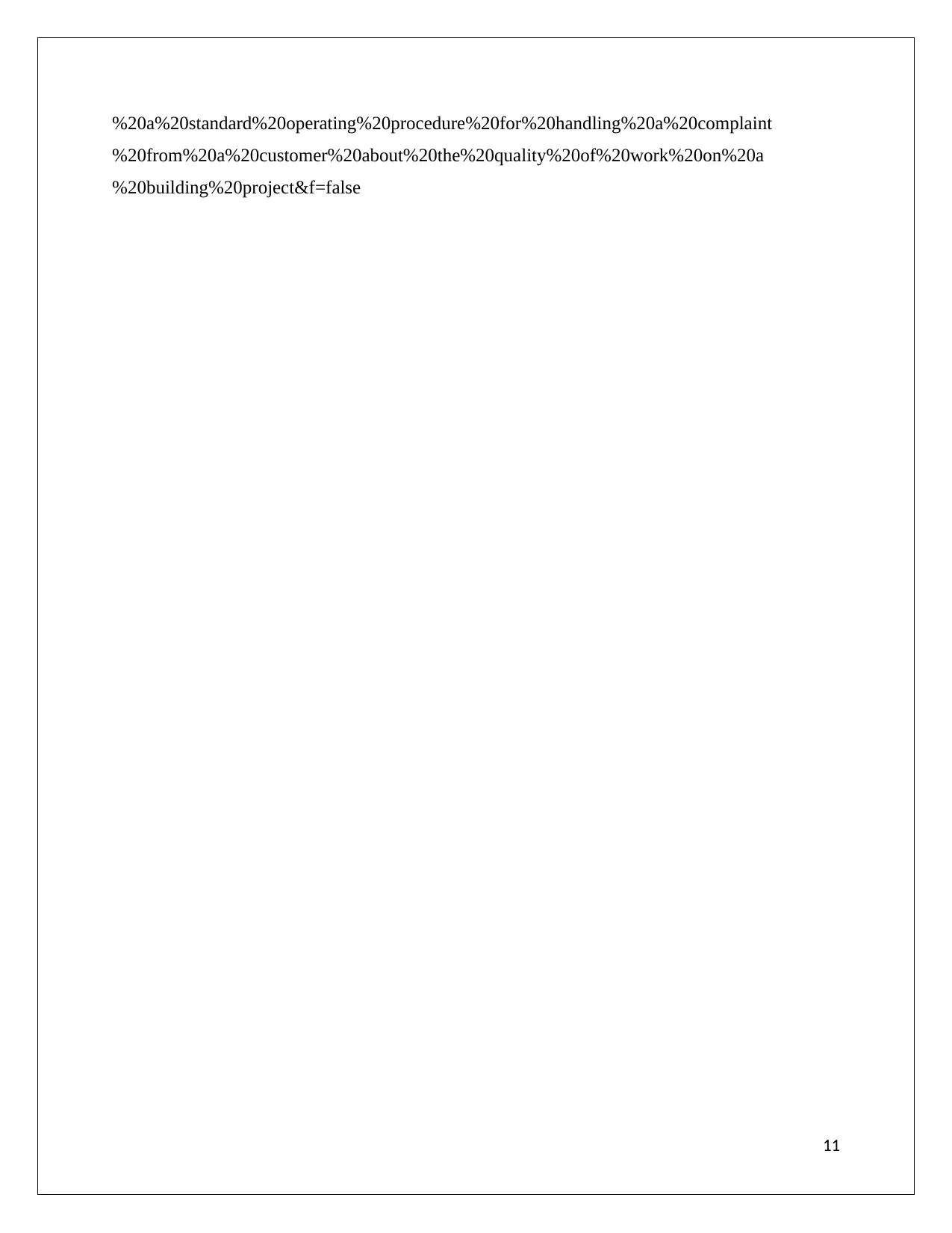
%20a%20standard%20operating%20procedure%20for%20handling%20a%20complaint
%20from%20a%20customer%20about%20the%20quality%20of%20work%20on%20a
%20building%20project&f=false
11
%20from%20a%20customer%20about%20the%20quality%20of%20work%20on%20a
%20building%20project&f=false
11
1 out of 11
Related Documents
Your All-in-One AI-Powered Toolkit for Academic Success.
+13062052269
info@desklib.com
Available 24*7 on WhatsApp / Email
![[object Object]](/_next/static/media/star-bottom.7253800d.svg)
Unlock your academic potential
© 2024 | Zucol Services PVT LTD | All rights reserved.





